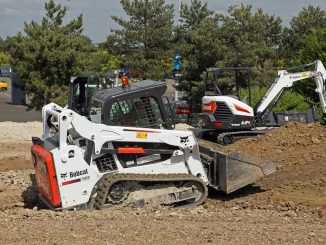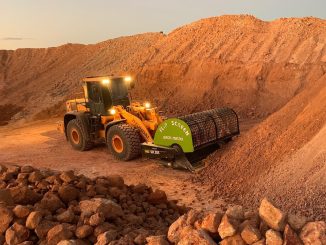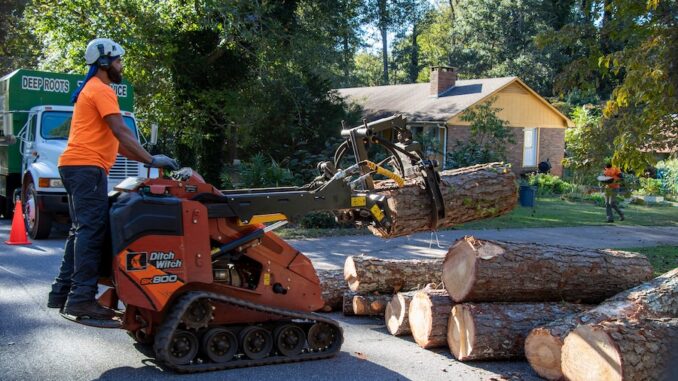
View the complete article here.
There must be hundreds of different types of attachments out there available for your skid steer, excavator—or whatever type of equipment you’re operating. And, each type of attachment serves its own purpose and has its own unique size and configuration. The possibilities are endless. There’s even a skid steer flamethrower, which you can read more about here.
Considering that the goal of any project is to get the job done as quickly, safely, and affordably as possible—the best contractors understand what their go-to attachments are and how to properly use them.
In this guide, we’re going to list the ten most efficient attachments available for earthmoving equipment and discuss why each made the list—as well as their applications, costs, troubleshooting tips, and more.
1. Buckets
Buckets are the quintessential attachment for earthmoving equipment—used for digging, loading, grading, as well as carrying various materials including soil, rocks, construction debris, and more.
Applications: Buckets are ideal for a wide array of tasks including excavation, landscaping, road construction, and mining.
Equipment: Buckets are compatible with most types of earthmoving equipment such as excavators, backhoes, skid-steer loaders, and wheel loaders.
Costs: Depending on the size, type, and brand—bucket prices can range from $500 for basic models to over $10,000 for larger, specialized buckets.
Troubleshooting: Common issues revolve around wear-and-tear on the bucket teeth and cutting edge. Regular inspection and replacement of these parts can help maintain optimal performance.
Manufacturer recommendations: Caterpillar, Komatsu, and JCB are some of the top-rated manufacturers known for producing high-quality, durable buckets.
Safety tips: Always verify that the bucket is securely attached before use. Also, avoid overloading the bucket as this can tip the machine.
Maintenance tips: Regularly clean the bucket after use to prevent buildup of material, inspect for cracks, and ensure that the attachments points are in solid condition.
Why are buckets considered one of the most efficient attachments for earthmoving equipment? Buckets are incredibly versatile. With the right bucket—operators can dig, grade, load, and carry various materials with one piece of equipment—increasing productivity and reducing the need for multiple machines.
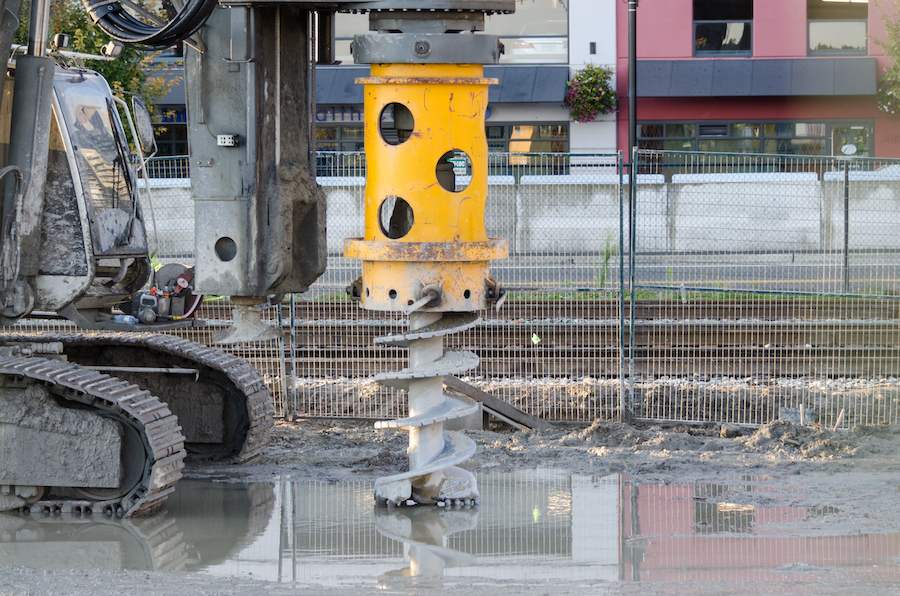
2. Augers
Augers are used for drilling holes into the earth—making them the perfect tool for tasks such as fencing, tree planting, or creating construction footings.
Applications: Augers are primarily used in landscaping, farming, construction, and any job that requires precise, deep drilling.
Equipment: Augers can be used with a variety of machines including skid-steer loaders, excavators, and backhoes.
Costs: Prices range from around $2,000 for smaller, basic models to over $10,000 for larger, more robust models.
Troubleshooting: Wear-and-tear on the drilling teeth is a common issue. If the auger isn’t drilling straight, it may be due to an imbalance in the auger or the teeth being worn more on one side.
Manufacturer recommendations: Bobcat, Premier, and Danuser produce some of the most reliable and efficient augers in the market.
Safety tips: Always clear the area of any underground utilities before drilling. Never stand directly over the auger while it’s in operation.
Maintenance tips: Regularly inspect and replace the teeth as necessary. Keep the auger clean and free of debris to maintain its performance and longevity.
Why are augers considered one of the most efficient attachments for earthmoving equipment? Augers can quickly and accurately drill holes of various depths and diameters. This precision and speed make them invaluable for jobs requiring extensive drilling, such as construction footings or fence installations—significantly saving time and effort.
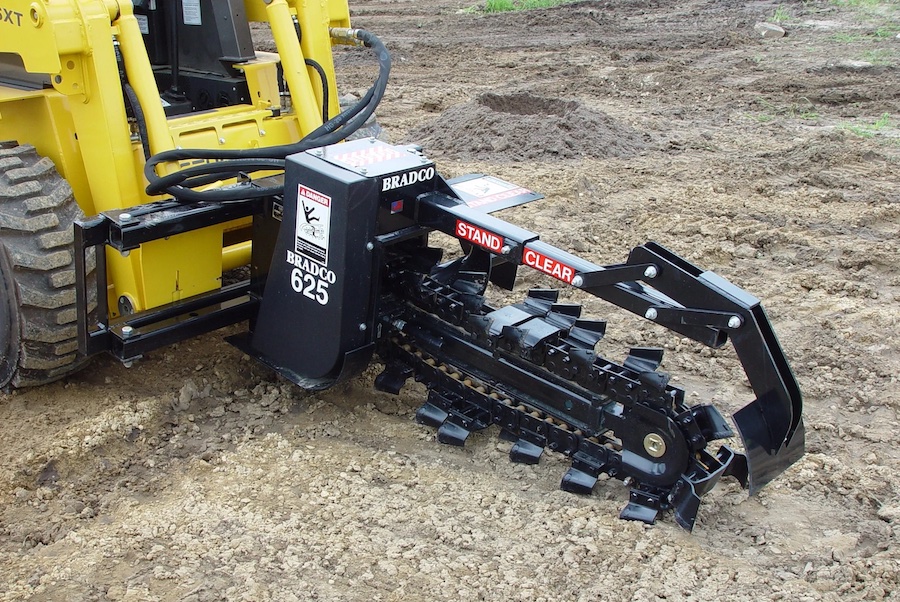
3. Trenchers
Trenchers are specialized attachments designed to dig narrow, deep trenches in the soil—often for the purpose of laying pipes or cables.
Applications: Trenchers are especially useful in construction, landscaping, and utility installation jobs.
Equipment: Trenchers can be used with skid-steer loaders and excavators.
Costs: Depending on size and capabilities, trencher attachments can cost between $3,000 and $10,000.
Troubleshooting: If the trencher is not cutting efficiently, it’s likely the teeth are worn or broken and will need to be replaced.
Manufacturer recommendations: Ditch Witch, Toro, and Vermeer are leading brands that offer high-quality trenchers.
Safety tips: Always mark the area before trenching to avoid underground utilities. Keep bystanders at a safe distance while operating the trencher.
Maintenance tips: Regularly check and replace the digging chain and teeth. Lubricate moving parts, as specified by the manufacturer.
Why are trenchers considered one of the most efficient attachments for earthmoving equipment? Trenchers enable the rapid and accurate creation of trenches. This makes tasks like laying pipes or cables more straightforward and quicker, reducing man-hours and boosting overall job productivity.
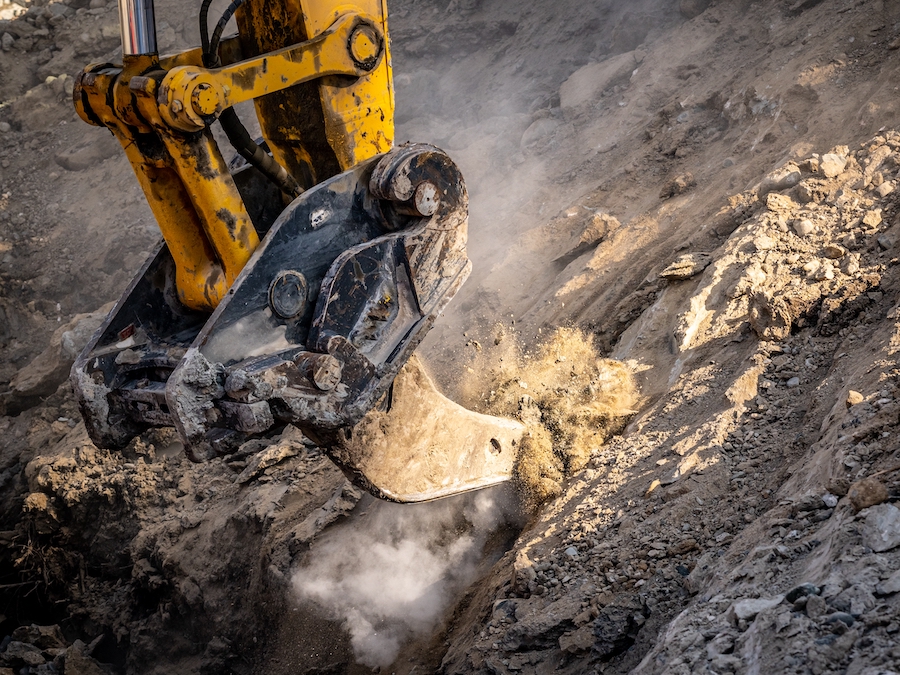
4. Rippers
Rippers are designed to penetrate and shatter hard soil and rock, loosening the ground for subsequent excavation or grading.
Applications: Rippers are particularly useful in construction, agriculture, and mining where the ground is compacted or frozen.
Equipment: Rippers are commonly used with bulldozers, motor graders, and excavators.
Costs: The price of a ripper attachment can range from $1,000 to $10,000, depending on its size and the type of earthmoving equipment it is designed for.
Troubleshooting: Keep a keen eye on wear-and-tear on the shanks and teeth, as these will require replacement once they become worn.
Manufacturer recommendations: Caterpillar, John Deere, and Komatsu are renowned manufacturers of high-performance rippers.
Safety tips: Ensure the area is clear of people and other equipment before operating. Be mindful of the potential for flying debris.
Maintenance tips: Regularly inspect the ripper teeth for wear, and apply grease to the shank and ripper tine as specified by the manufacturer.
Why are rippers considered one of the most efficient attachments for earthmoving equipment? Extremely efficient at breaking up hard ground, frozen soil, or pavement—rippers prepare these challenging surfaces for subsequent excavation or grading, which would have been time-consuming and labor-intensive.
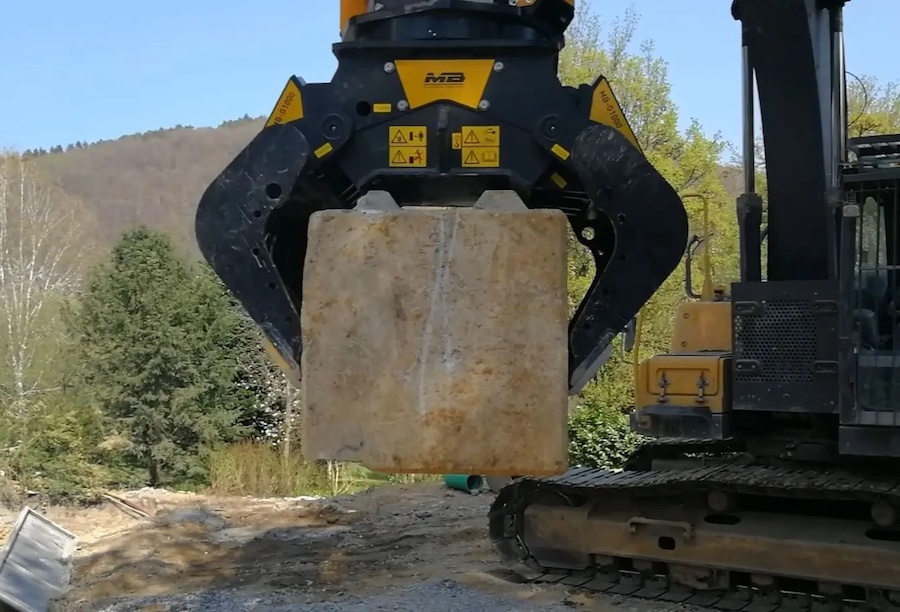
5. Grapples
Grapples are designed for grasping, lifting, and moving a variety of materials—with types including demolition grapples, log grapples, and scrap grapples.
Applications: Grapples are particularly useful in waste and scrap handling, forestry, landscaping, and demolition tasks.
Equipment: Grapples can be attached to a variety of machines—including skid-steer loaders, wheel loaders, and excavators.
Costs: Depending on the type and size, grapples can range from $2,000 to over $10,000.
Troubleshooting: Regularly check the grapple’s hydraulic lines for leaks and inspect the grapple teeth for excessive wear or damage.
Manufacturer recommendations: Leading manufacturers like Kinshofer, Bobcat, and Rotobec are known for their high-quality grapples.
Safety tips: Never use a grapple to lift items over people or property. Ensure the load is secure before moving.
Maintenance tips: Regularly lubricate pivot points and inspect for any signs of damage or excessive wear.
Why are grapples considered one of the most efficient attachments for earthmoving equipment? Grapples have the ability to quickly and securely grab, lift, and move various materials. Their ability to handle irregular or difficult-to-manage loads makes them essential in tasks such as waste management, forestry, and demolition.
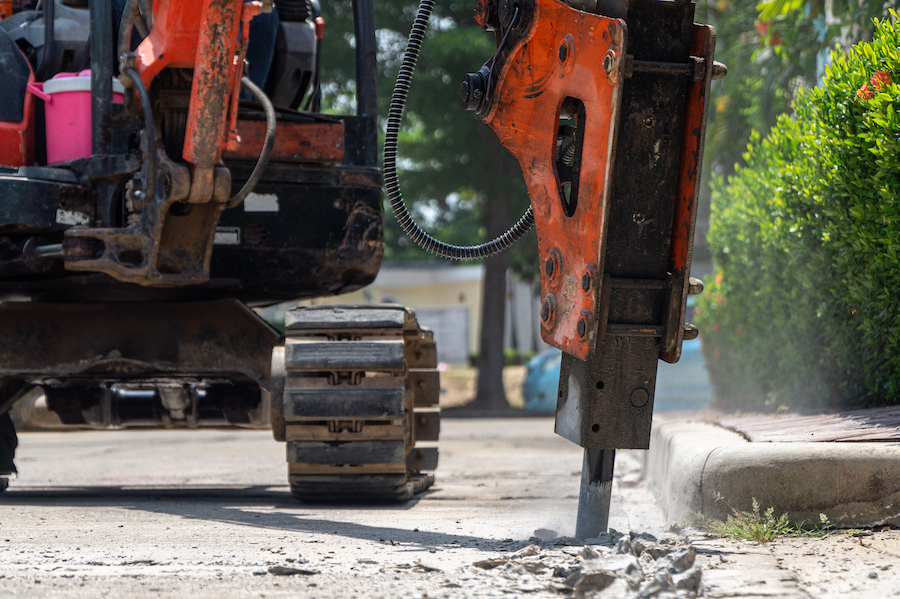
6. Hydraulic Breakers/Hammers
Hydraulic breakers—also known as hammers—are designed for breaking through concrete, rocks, and asphalt.
Applications: Hydraulic breakers are ideal for construction, demolition, and mining.
Equipment: Hydraulic breakers can be used with a variety of machines—including skid-steer loaders, backhoes, and excavators.
Costs: Prices range from around $5,000 for smaller models to over $30,000 for larger, heavy-duty models.
Troubleshooting: Keep an eye out for signs of hydraulic fluid leakage and worn or broken chisel points.
Manufacturer recommendations: Atlas Copco, Montabert, and Indeco offer some of the market’s most robust and efficient hydraulic breakers.
Safety tips: Always wear appropriate protective equipment, including ear and eye protection, when operating a hydraulic breaker. Maintain a safe distance from the impact area.
Maintenance tips: Regularly check the breaker’s bushings and chisels for wear and replace as necessary. Ensure proper hydraulic flow and pressure for optimal performance.
Why are hydraulic breakers considered one of the most efficient attachments for earthmoving equipment? Hydraulic breakers can quickly and effectively break through concrete, rocks, and asphalt—making them essential in construction and demolition tasks.
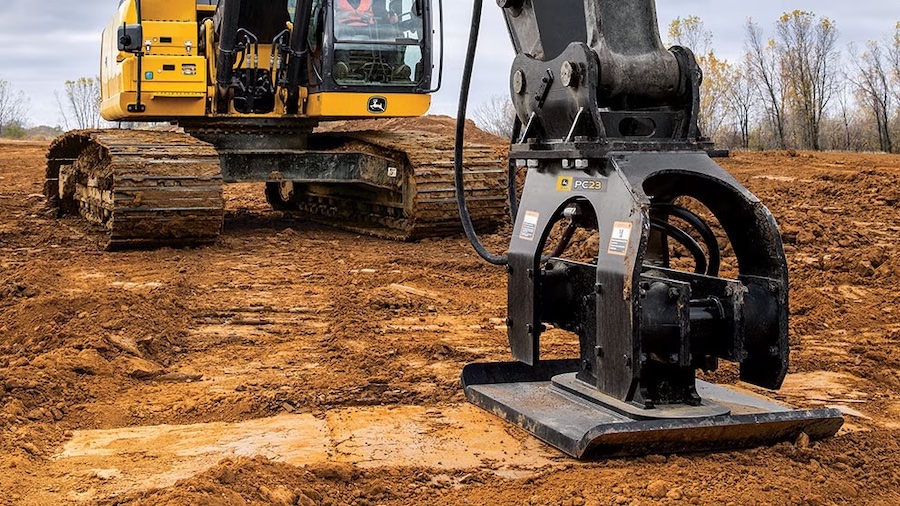
7. Compaction Wheels/Rollers
Compaction attachments are designed for compacting soil in trenches or other confined areas.
Applications: Compaction attachments are ideal for construction, roadwork, and utility installation jobs.
Equipment: Compaction attachments are primarily used with excavators and backhoes.
Costs: Depending on size and specific model, compaction wheel prices can range from $2,000 to $10,000.
Troubleshooting: Regularly inspect the attachment for any damage or wear to the wheel/roller surface.
Manufacturer recommendations: Brands like Sheepsfoot, Caterpillar, and Bomag are highly respected for their efficient and robust compaction attachments.
Safety tips: Always ensure that the work area is clear of people and obstacles before operating the compactor. Avoid operating on overly steep slopes to prevent tipping.
Maintenance tips: Regularly check the wheels or drum for signs of damage and keep bearings lubricated as specified by the manufacturer.
Why are compaction attachments considered one of the most efficient attachments for earthmoving equipment? Compaction attachments allow for rapid, even compaction of soil in trenches or other confined spaces. This simplifies and accelerates tasks like preparing a roadbed or laying utility lines.
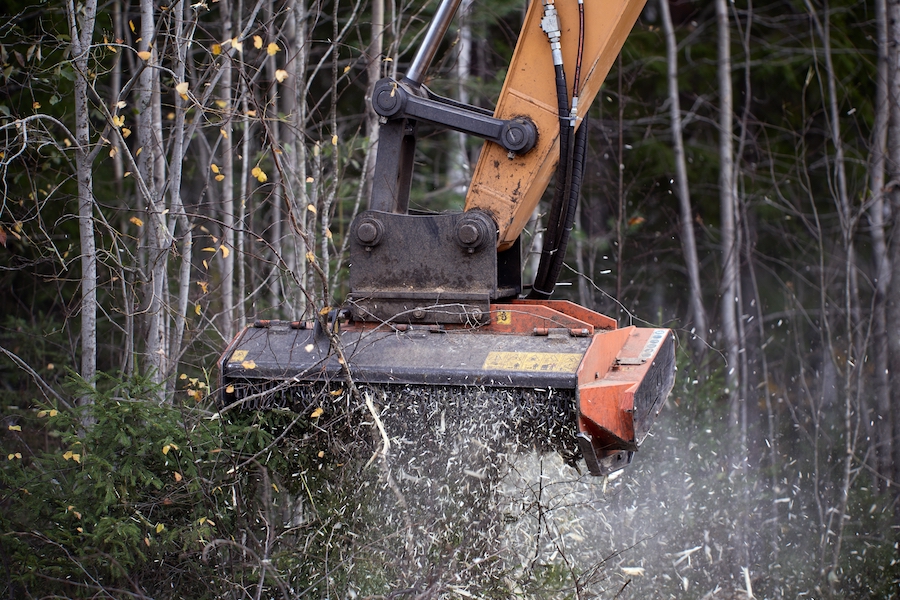
8. Mulchers
Mulchers are used for cutting and grinding vegetation, transforming it into mulch on-site.
Applications: Mulchers are ideal for land clearing, forestry, and landscaping tasks.
Equipment: Mulchers can be attached to various machines, including skid-steer loaders and excavators.
Costs: Depending on the size and power of the unit, mulcher attachments can range from $10,000 to over $30,000.
Troubleshooting: If the mulching performance is reduced, inspect the teeth for damage or wear.
Manufacturer recommendations: Fecon, FAE, and Bradco are leading brands that produce high-quality mulchers.
Safety tips: Always ensure that no one is within the risk zone before operating. Be aware of the risk of flying debris and wear appropriate protective gear.
Maintenance tips: Regularly check and replace the teeth as necessary. Keep the hydraulic lines clean and check regularly for leaks.
Why are mulchers considered one of the most efficient attachments for earthmoving equipment? Mulchers are extremely efficient in clearing vegetation by cutting and grinding it into mulch on-site. This eliminates the need for hauling away debris, saving time and costs.
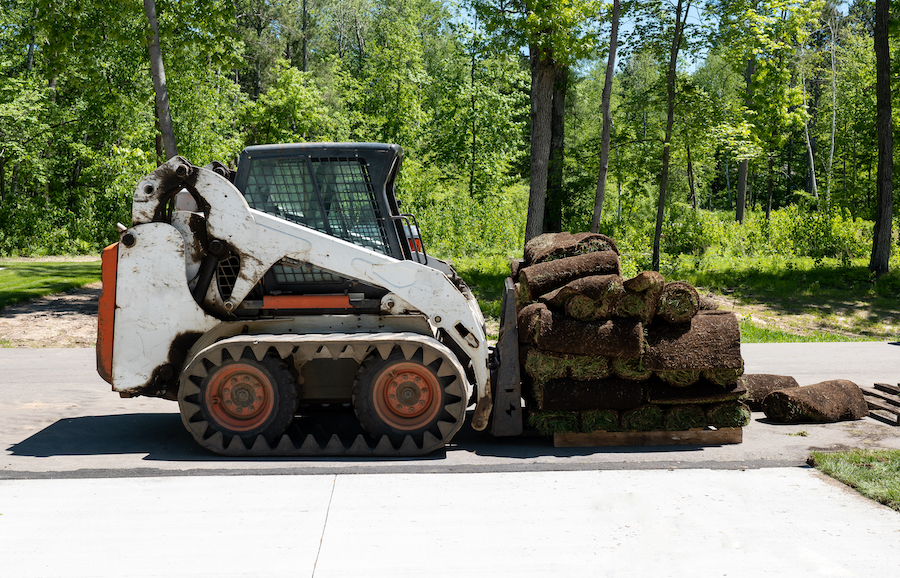
9. Pallet Forks
Pallet forks are used to lift and move pallets and other materials around the job site.
Applications: Pallet forks are ideal for construction, agriculture, and warehousing jobs.
Equipment: Pallet forks are primarily used with skid-steer loaders, compact track loaders, and wheel loaders.
Costs: Pallet fork attachments are relatively affordable, ranging from $500 to $1,500.
Troubleshooting: Regularly check the forks for signs of bending or other damage. Ensure the locking mechanism is secure before lifting.
Manufacturer recommendations: Top brands like Bobcat, John Deere, and Kenco offer reliable and efficient pallet forks.
Safety tips: Always check the weight limit before lifting loads and avoid abrupt movements to prevent load imbalance.
Maintenance tips: Regularly inspect the forks for wear or damage and keep the fork shaft lubricated.
Why are pallet forks considered one of the most efficient attachments for earthmoving equipment? Pallet forks have the unique ability to quickly and safely move pallets and other materials around the job site. This aids in keeping the site organized and helps speed up tasks such as loading and unloading.
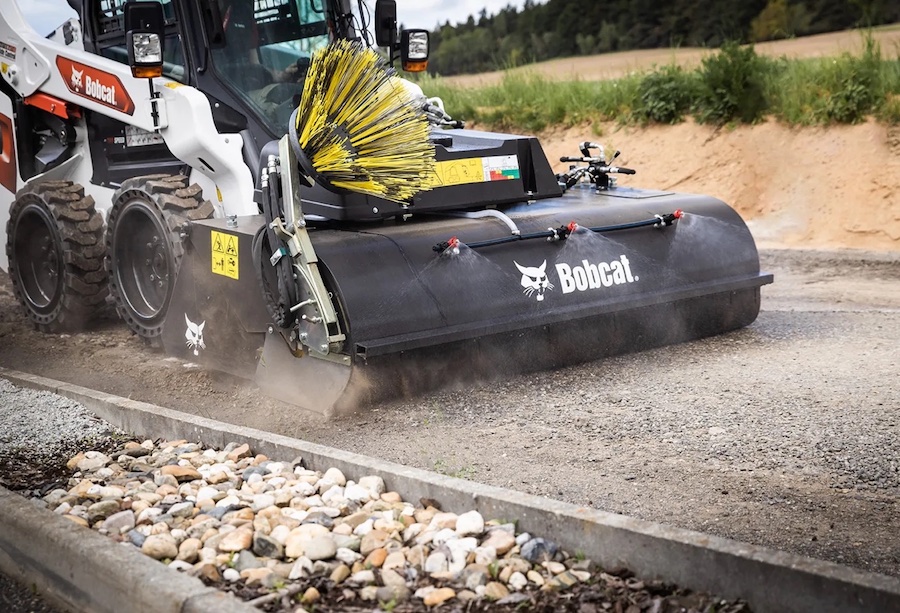
10. Sweepers
Sweeper attachments are used to clean up debris on the job site.
Applications: Sweeper attachments are ideal for road construction, industrial applications, and general job site cleanup.
Equipment: Sweepers are primarily used with skid-steer loaders and compact track loaders.
Costs: Sweeper attachments typically range from $3,000 to $10,000.
Troubleshooting: Check the bristles for wear-and-tear and replace them as needed.
Manufacturer recommendations: Bobcat, Caterpillar, and Kärcher are some of the best manufacturers to consider when purchasing sweeper attachments.
Safety tips: Always ensure the area is clear of people and objects before operating. Wear appropriate protective gear to protect against flying debris.
Maintenance tips: Regularly clean and inspect the sweeper for any damage. Check the hydraulic motor for smooth operation and any signs of leaks.
Why are sweeper attachments considered one of the most efficient attachments for earthmoving equipment? Sweeper attachments can quickly clean up debris over large areas, saving significant time and effort compared to manual cleaning methods. This keeps job sites safe and improves operational efficiency.
Conclusion
Earthmoving equipment attachments are indispensable tools in the construction industry. These diverse and capable devices transform heavy machinery into versatile workhorses, enabling them to perform a variety of challenging tasks. Whether you’re scooping soil with a bucket or clearing debris with a sweeper, the right attachment can make a world of difference to the efficiency and productivity of your project.
Understanding the different aspects of these attachments—from their purposes and applications, to their costs and recommended manufacturers—is a crucial factor in leveraging their full potential. And, equally important are their safety protocols and regular maintenance—as these can ensure optimal performance and longevity of the attachments.
And, who knows the future holds… As technology continues to evolve, we can expect to see an increase in both the variety and capabilities of these attachments. We can’t wait.
View the complete article here.
What are the essential safety tips for operating hydraulic breakers on earthmoving equipment?
Always wear protective gear, maintain a safe distance from the impact area, and regularly check for hydraulic fluid leaks, worn chisel points, and proper hydraulic flow and pressure.
What is the typical cost range for pallet fork attachments, and what applications are they suitable for?
Pallet fork attachments range from $500 to $1,500, and they are ideal for construction, agriculture, and warehousing jobs, allowing for the efficient lifting and moving of pallets and materials around the job site.






































